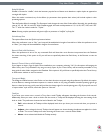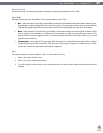
Torq User Guide » Chapter 1
78
Torq User Guide » Chapter 15
78
Auto-Detect M-Audio Devices ([On]/Off)
When this option is enabled, Torq will automatically set the Audio and MIDI interface options to those of any known
M-Audio controller and interface that is connected to your system. This will ensure proper operation of Torq and connected
devices.
Note: If you have created a custom mapping for your controllers or special assignments for your audio interface and don’t want Torq
to replace these mappings with the defaults upon the next startup, leave this option turned off.
Scratch Sensitivity
This option allows you to congure how rapidly a Deck
will respond to messages sent from a MIDI controller. It is
designed for controllers that will move the waveform back
and forth, like a scratch DJ.
1. By increasing the number, the Deck will respond
more rapidly.
2. By decreasing the number, the Deck will respond
more slowly.
Nudge Sensitivity
This setting allows you to adjust Torq’s sensitivity to “nudging”
or gradually slipping the phase of one deck to match the
phase of the other deck.
By default this parameter is set to 5, however:
1. By increasing the number, the Deck will nudge your
track more rapidly.
2. By decreasing the number, the Deck will nudge your
track more gradually.
Note that this setting differs from the “Scratch Sensitivity”
parameter which changes Torq’s sensitivity to scratches, which
“push” or “pull” your waveform much more quickly and forcefully
than a nudge. Unlike a scratch, a nudge very gently slows down or speeds up a track and is used to ne tune the timing of two
tracks.
Crossfader Curve Control
This preference allows you to assign a MIDI controller to the Crossfader Curve parameter. You can then control the
Crossfader Curve with a knob or slider on your MIDI controller.
1. Press the button labeled “Learn” to activate it.
2. Turn a knob on your MIDI controller.
3. Torq will immediately assign the knob to the Crossfader Curve. Check this by looking at the Crossfader graphic in
the main window while turning the knob.
MIDI SHIFT Key
When using Torq, the SHIFT key on your computer’s keyboard is used rather often. This option lets you assign a MIDI Note
to function as “SHIFT” in Torq, thus allowing you to do SHIFT-based combinations (such as SHIFT+Nudge) entirely from
an external MIDI controller. To assign a MIDI note:
1. Press the button labeled “Learn” to activate it.
2. Push a button or key on your MIDI controller.
3. Torq will immediately assign the button as a Shift key for use within the program.
DJ oriented MIDI controllers with turntable platters
will vary in how they handle scratching and nudging.
Certain products will allow you to control only
nudging, while others (such as the M-Audio Xponent)
will allow you to control both nudging and scratching.
Refer to the product’s user guide to learn if each
turntable platter is capable of sending out both MIDI
note and CC information. If so, assign each turntable’s
MIDI note and CC commands to the corresponding
Main Waveform Display in Torq (this is done using
the “MIDI Learn” feature described in the MIDI
Preferences section of this guide).
If your turntable can only send out MIDI CC
information but not MIDI note data (i.e., the turntable
is not touch sensitive), then you will only be able to
control nudging. Assign the turntable’s MIDI CC
output to control the corresponding Main Waveform
Display in Torq (again, this is done using the “MIDI
Learn” feature described in the MIDI Preferences
section of this guide).


















